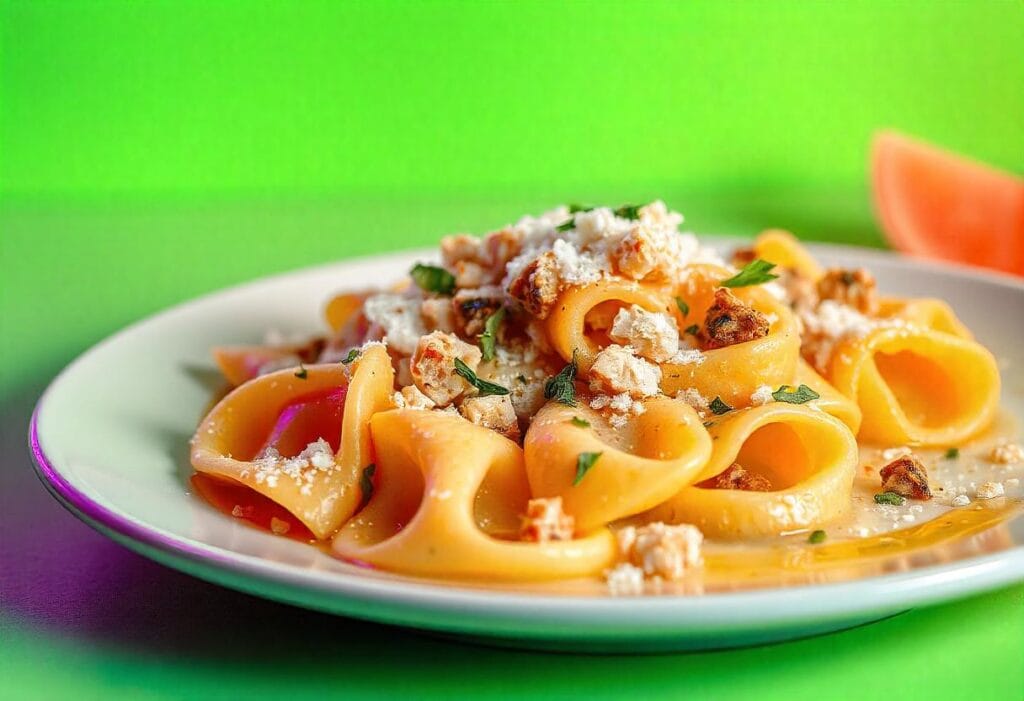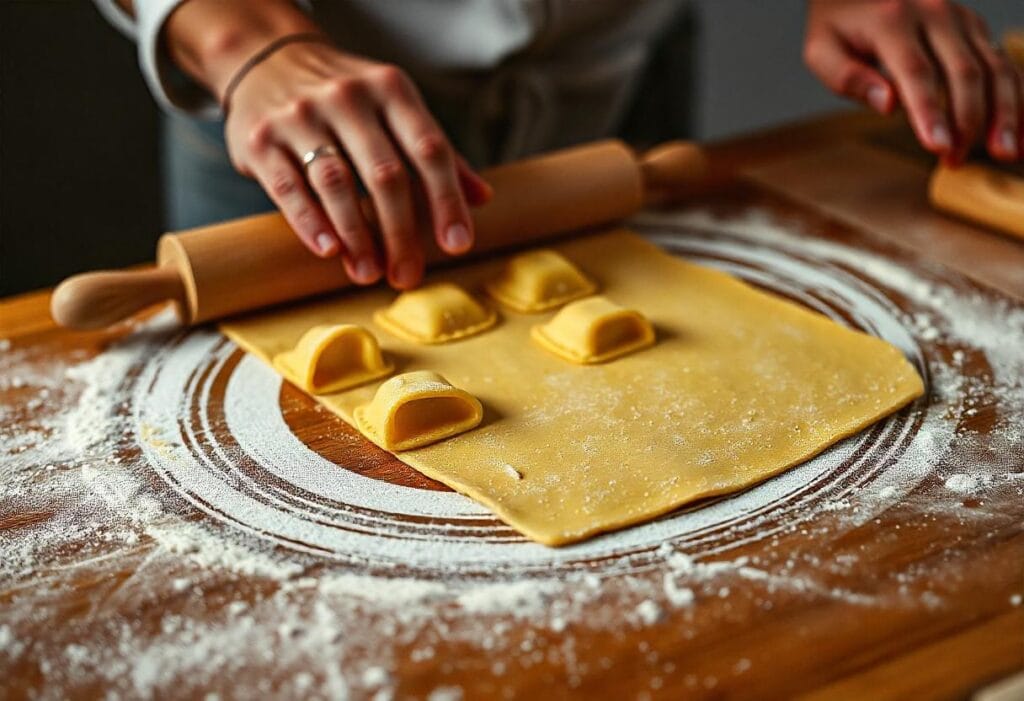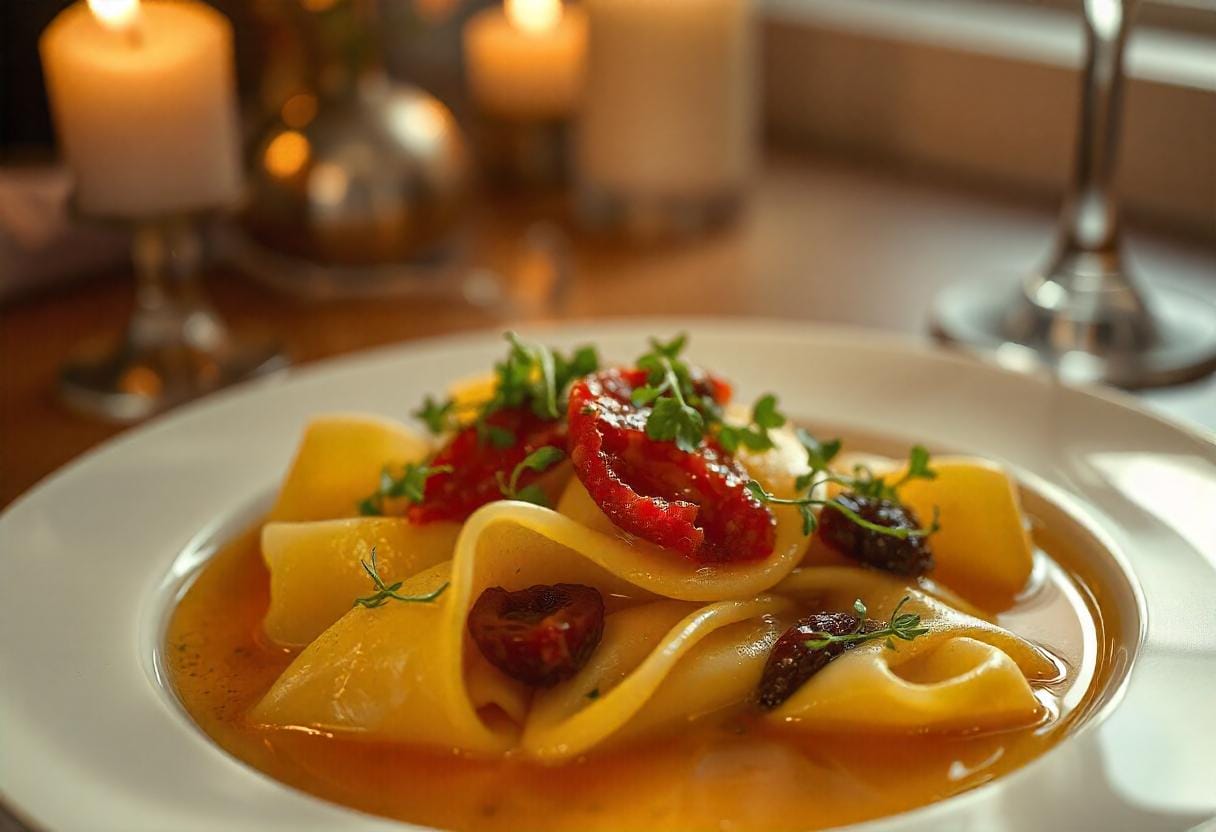Table of Contents
When we think about Italian cuisine, one of the first things that comes to mind is pasta. Italians have perfected the art of pasta making, with each region boasting its own specialty. One of the lesser-known but absolutely delicious varieties is cappelletti pasta. But what exactly is cappelletti, and why has it become such an important part of Italy’s culinary culture? Let’s dive into the world of cappelletti pasta, its rich history, and the mouthwatering ways it’s enjoyed.
What is Cappelletti Pasta?
At its core, cappelletti is a type of stuffed pasta that is most commonly associated with the regions of Emilia-Romagna and Marche in Italy. It resembles other stuffed pastas like ravioli, but with a slight difference in shape and texture. While ravioli is typically square or rectangular, cappelletti are smaller, round or hat-shaped pouches.
The name “cappelletti” comes from the Italian word for “little hats” because of their resemblance to the traditional caps worn by clergy. The pasta is typically filled with a variety of ingredients, from rich cheeses to meats, and is usually served in broth or with a light sauce.
If you’re curious about the origins and cultural significance of cappelletti, read our guide on the meaning of cappelletti pasta to uncover its deep-rooted Italian history.
The Origin and History of Cappelletti
The roots of cappelletti pasta can be traced back to Italy’s central regions, particularly in Emilia-Romagna and Marche. It’s said that cappelletti first appeared in the medieval Italian kitchens, likely during the 12th century, although the exact origin story is somewhat cloudy. Many historians believe that cappelletti was created as a way to utilize leftover meats or cheeses by stuffing them into pasta dough.
If you want to learn how to shape and fold this delicious pasta at home, check out our step-by-step tutorial on how to fold cappelletti pasta for the best techniques.
“Cappelletti pasta, much like its Italian siblings, is all about the artistry of balancing simple ingredients to create something truly exceptional.” – Italian Food Enthusiast 🍝
How Cappelletti Differs from Other Pasta
When comparing cappelletti to other stuffed pastas like ravioli and tortellini, the key differences lie in shape, size, and filling. While ravioli are often square or rectangular pockets of pasta, cappelletti has a more distinct, small hat-like shape. Tortellini, on the other hand, is also hat-shaped but is generally smaller and more tightly folded.
Cappelletti pasta is often compared to other stuffed pastas, particularly tortellini. Learn more about the key differences between tortellini and cappelletti and what makes each unique.
The fillings inside these pastas also vary. Ravioli tends to have a wider range of fillings, from cheeses to vegetables to meats, while cappelletti is traditionally filled with cheese and meat, such as pork or veal. Furthermore, cappelletti is often served in a broth, whereas ravioli is more commonly found in saucy dishes.
Despite these distinctions, all three types of stuffed pasta share a similar cooking method: they’re boiled and can be served either fresh or dried. However, the filling and broth combination makes cappelletti truly unique.
Traditional Cappelletti Fillings
As mentioned, cappelletti is traditionally filled with cheese or meat, but there are many variations depending on the region and family recipe.
Want to explore the best ways to enjoy cappelletti? Find out what cappelletti is used for and how to incorporate it into your cooking.
Cheese-filled Cappelletti: A Classic Choice
One of the most common fillings for cappelletti is cheese, and it’s typically made from a blend of ricotta and Parmesan. The rich, creamy ricotta balances the salty, sharp taste of Parmesan, creating a delicious contrast that works beautifully inside the soft pasta dough. Some variations also incorporate a touch of egg or herbs for extra flavor.
These cheese-filled cappelletti are often served in broth, where the cheese melts slightly, enriching the flavor of the soup. It’s a classic dish that’s perfect for special occasions or when you want to treat yourself to something comforting yet elegant.
« A warm bowl of cheese-filled cappelletti in broth is like a hug in a bowl. Simple, yet extraordinarily satisfying! » 🧀🍜
Meat-filled Cappelletti: Rich and Flavorful
For those who prefer a heartier option, meat-filled cappelletti is a wonderful choice. Pork, veal, and sometimes beef are the most common meats used for the filling. The meat is finely ground and often mixed with a variety of spices and herbs, such as nutmeg and garlic, to enhance the flavor. Some recipes may even incorporate a bit of cheese or broth into the filling for added richness.
These meat-filled cappelletti are traditionally served in broth, allowing the flavors to meld together and create a warm, savory dish. It’s a fantastic option for colder weather or when you’re in the mood for a comforting, protein-packed meal.
How to Make Cappelletti Pasta at Home
Making cappelletti from scratch might sound daunting, but it’s easier than you think! With a little time, patience, and a few ingredients, you can create this beautiful dish right at home. Let’s break it down into steps:
Making the Pasta Dough from Scratch
The dough for cappelletti is relatively simple, and it only requires flour, eggs, and sometimes a touch of water. The key is to knead the dough until it’s smooth and elastic, then let it rest to relax the gluten. This step is essential for achieving the tender texture that cappelletti is known for.
Preparing the Filling for Cappelletti
While the dough is resting, you can prepare the filling. Whether you choose a cheese or meat filling, the process is quite straightforward. For cheese-filled cappelletti, simply combine ricotta, Parmesan, and a few seasonings. For meat-filled versions, brown the meat, mix it with spices, and allow it to cool before using.

Shaping and Folding the Cappelletti
Once your dough has rested, roll it out into thin sheets, cut them into squares, and place a small amount of filling in the center of each square. Then, fold the dough into a triangle, pinching the edges together to seal it tightly. Finally, fold the triangle into a little hat shape, pressing the edges firmly.
Now you’re ready to cook your cappelletti!

Cappelletti Pasta Sauces and Pairings
Now that you’ve mastered the art of making cappelletti, it’s time to think about how to serve it! The type of sauce you choose can make or break your dish, and cappelletti pairs well with a variety of sauces. Let’s explore some of the most popular ways to enjoy your cappelletti pasta.
Classic Broth-based Sauces for Cappelletti
The most traditional way to serve cappelletti is in broth. This method is commonly used in Emilia-Romagna, where cappelletti in brodo (cappelletti in broth) is a beloved dish. The broth, usually made from beef, chicken, or vegetable stock, complements the delicate flavors of the pasta and the filling inside. The key to a perfect broth-based sauce is a rich, well-seasoned broth that infuses the cappelletti with a comforting, hearty flavor.
When serving cappelletti in broth, it’s common to sprinkle some grated Parmesan or fresh herbs on top for added flavor. The combination of the soft, creamy pasta and the savory broth is truly a match made in heaven.
« Cappelletti in broth is the ultimate comfort food — light yet full of flavor, and perfect for a cozy dinner. » 🍲✨
Tomato and Cream Sauces to Elevate Your Cappelletti
If you prefer a more robust flavor, tomato-based sauces or cream sauces are an excellent choice for cappelletti. A classic tomato sauce made with garlic, onion, and a touch of basil pairs wonderfully with meat-filled cappelletti, while a creamy Alfredo sauce complements cheese-filled cappelletti perfectly.
Tomato sauces give a slight acidity that balances out the richness of the fillings, while a creamy sauce enhances the velvety texture of the cappelletti, making it feel like a more indulgent meal. For a truly decadent experience, you can combine both a tomato and cream sauce, creating a rich, flavorful base that coats every bite of your pasta.
« Whether you prefer tomato or cream-based sauces, cappelletti will absorb all those beautiful flavors and elevate your meal. » 🍅🍝
Savory Pairings and Sides for Cappelletti
While cappelletti can be served on its own in broth or sauce, it’s also delicious when paired with some simple sides. For a traditional touch, serve your cappelletti alongside a green salad dressed in olive oil, lemon, and balsamic vinegar. The freshness of the salad cuts through the richness of the pasta and makes for a well-balanced meal.
Another excellent pairing for cappelletti is roasted vegetables. Caramelized onions, roasted carrots, or zucchini can complement the flavors of the pasta and add some texture to the dish.
Common Problems When Making Cappelletti Pasta and How to Solve Them
Making cappelletti from scratch is a rewarding experience, but it’s not without its challenges. Let’s take a look at some common problems people face when making cappelletti and how to solve them to ensure your pasta turns out perfectly every time.
Problem 1: The Dough Is Too Dry
One of the most common issues people face when making cappelletti is that the dough becomes too dry, making it difficult to roll out and shape. This can happen if you don’t add enough water or egg to the dough, or if the dough hasn’t been kneaded properly.
Solution:
To fix this, start by adding a small amount of water or extra egg to the dough, a little at a time, until it becomes soft and pliable. Also, make sure you knead the dough thoroughly to activate the gluten and create the perfect texture.
Problem 2: The Filling Is Too Runny
Another common issue is a runny filling, especially with cheese-filled cappelletti. If the filling is too wet, it can leak out during cooking and create a mess.
Solution:
To prevent this, make sure your filling is not too liquid. For cheese-filled cappelletti, drain any excess moisture from ricotta or other cheeses before mixing them with other ingredients. For meat fillings, make sure the meat is fully cooled before adding it to the dough.
Problem 3: The Pasta Won’t Hold Its Shape
Sometimes, the cappelletti won’t hold their shape and may unravel or lose their form during cooking. This can happen if the pasta dough isn’t sealed tightly enough or if the pasta is too thick.
Solution:
To avoid this, make sure that the edges of the dough are pinched together firmly to seal the filling inside. Additionally, don’t make the pasta too thick, as this can cause the cappelletti to lose their shape during cooking. If needed, you can rest the dough for a bit to make it more pliable and easier to work with.
Health Benefits of Cappelletti Pasta
Like most traditional Italian dishes, cappelletti is made with wholesome ingredients. While it’s often considered a comfort food, it can offer some health benefits when prepared with balanced ingredients.
Nutritional Value of Cappelletti Pasta
The key ingredients in cappelletti — flour, eggs, cheese, and meat — are all rich in essential nutrients. Eggs provide protein and healthy fats, while cheese is a good source of calcium and vitamins. If you opt for a vegetable-based broth or sauce, the dish can also be packed with vitamins and minerals from the vegetables.
In moderation, cappelletti can be a satisfying, nutrient-dense meal. Just be mindful of portion sizes, as the richness of the fillings and sauces can make it a bit indulgent.
Making Healthier Versions of Cappelletti
If you’re looking for a healthier twist on this classic dish, consider making some adjustments to the filling and dough. You could try using whole wheat flour for the dough or add more vegetables to the filling. For a lighter option, consider using leaner meats or opting for a vegetarian filling.
Where to Find Authentic Cappelletti Pasta
If you’re not up for making cappelletti from scratch, don’t worry! Authentic cappelletti can be found at many Italian markets or specialty grocery stores. You can also check out online stores that sell fresh or frozen cappelletti.
When shopping for cappelletti, look for options that are made with high-quality ingredients. It’s always best to choose pasta that’s freshly made or properly frozen to preserve its delicate flavor and texture.
Frequently Asked Questions (FAQ)
1. What is the difference between cappelletti and tortellini?
Both cappelletti and tortellini are types of stuffed pasta, but they differ in size and shape. Cappelletti are generally larger and more hat-shaped, while tortellini is typically smaller and more tightly folded. Cappelletti also tends to have more variations in its fillings, with some versions containing meats and others filled with cheese or vegetables.
2. Can I make cappelletti pasta without a pasta machine?
Absolutely! You can make cappelletti dough by hand, although using a pasta machine can make rolling out the dough much easier and more consistent. If you don’t have a pasta machine, simply roll the dough out using a rolling pin until it’s thin enough to cut into squares for the filling. The most important thing is to ensure the dough is smooth and elastic.
3. How do I store leftover cappelletti?
If you have leftover cappelletti that hasn’t been cooked, you can store it in the freezer. Place the uncooked cappelletti in a single layer on a baking sheet to freeze it individually. Once frozen, transfer the pieces to an airtight container or freezer bag for long-term storage. If cooked, store the leftover pasta in an airtight container in the fridge for up to 2-3 days. Reheat in broth or with sauce.
4. Can cappelletti pasta be served in something other than broth?
While cappelletti is traditionally served in broth, it can certainly be served with sauces instead. You can pair meat-filled cappelletti with a tomato sauce or cream-based sauce, while cheese-filled cappelletti works well with a light butter sauce or pesto. The versatility of cappelletti allows it to adapt to many different flavor profiles.
5. Is cappelletti gluten-free?
Traditional cappelletti is made from wheat flour, so it is not gluten-free. However, you can make a gluten-free version by using a gluten-free flour blend. Just be sure to check the ingredients and texture before making the pasta, as gluten-free pasta can sometimes be more delicate to handle than regular pasta.
6. Can I make cappelletti ahead of time?
Yes! Cappelletti can be made ahead of time and either refrigerated or frozen for later use. If you’re planning to make it ahead, simply prepare the pasta, store it in a container, and refrigerate for up to 2 days or freeze it for up to 3 months. This makes it a great option for meal prepping or preparing for a big family dinner.
7. How long does cappelletti take to cook?
Cappelletti typically cooks quite quickly, usually in 3-5 minutes if fresh. If you’re using frozen cappelletti, you may need to cook it for an extra minute or two. The key is to test the pasta to ensure it’s tender and the filling is hot before serving.
Conclusion: The Joy of Eating Cappelletti
Whether you make it yourself or buy it from a store, cappelletti pasta is a true Italian delicacy that brings comfort and flavor to any meal. With its rich history, versatile fillings, and ability to pair with a variety of sauces, it’s easy to see why cappelletti is so beloved in Italian cuisine.
By following some simple tips and tricks, you can avoid common mistakes and create a perfect batch of cappelletti every time. So why not give it a try? Your taste buds will thank you!

